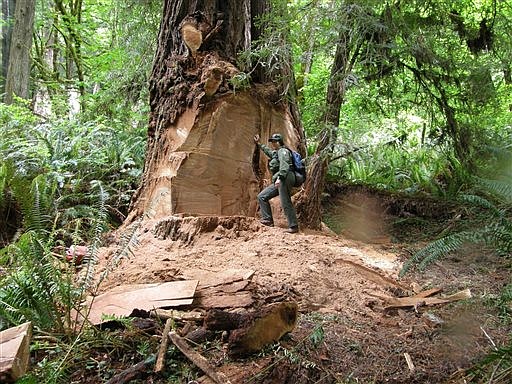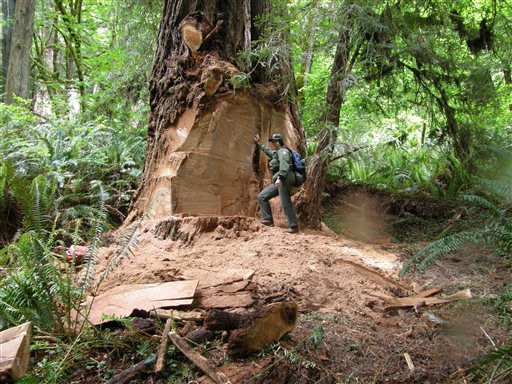GRANTS PASS, Ore. - The poaching of knobby growths on ancient redwood trees has spread to national forests in Northern California and Oregon.
The growths, known as burls, appear at the base of redwood trees, where they send out sprouts. Their intricate grain is prized for furniture and decorations.
The poaching has been a problem in Northern California's Redwood National and State Parks for years. Two men recently were convicted in a case there after rangers tracked slabs cut from a tree by chain saw to a redwood burl shop.
Wendell Wood of the conservation group Oregon Wild says he was out hiking recently and found two redwood trees with burls cut off.
One was along the South Fork of the Smith River on the Six Rivers National Forest near Crescent City, California. The other was along the Winchuck River on the Rogue River-Siskiyou National Forest near Brookings, Oregon, in a stand that represents the northernmost reach of coast redwoods.
"I just casually stumbled into them," Wood said.
Each scar was about 2 feet square or less, he said. At the Oregon site, the poachers cut down nearby trees so they could turn their vehicle around on the narrow road.
Oregon Wild wants the forests to close old logging roads that poachers drive to reach the remote trees. Besides protecting the trees, it would stop people from dumping garbage on the roads, which are barely passable, even by four-wheel-drive vehicles, Wood said.
He noted that with few rangers to patrol for poachers, the National Park Service imposed a nighttime closure on a road running by the most recent poaching discovery on the park.
"We are not telling the Forest Service how they should best protect it," Wood said. "But we want them to recognize that the national park is clamping down on this and managing their resources more strategically. This problem has moved into Oregon and onto the national forest. So the forest needs to be looking at it."
The U.S. Forest Service had no comment on whether it might close roads, but said it is investigating.
"We take damage to natural resources on national forest system lands very seriously and are investigating the theft of the burls," regional spokesman Tom Knappenberger said in an email. "This potentially is a felony violation."
A redwood tree can survive a burl being cut off, but the legacy of an organism that could be 1,000 years old is threatened, because the burl is where it sprouts a clone before dying. Sprouting from burls is the prevalent method of redwood propagation.

